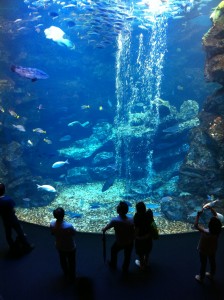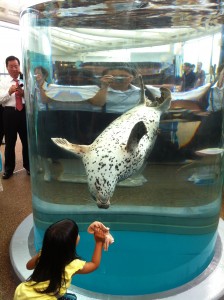
 Almost three months after the opening day (14th March 2012), I’ve had the opportunity to visit the Kyoto Aquarium (京都水族館) for the first time. The idea to finally visit the place was initiated last month by a student at Smith’s English Kyobashi (スミス 英会話 京橋) who, before his English conversation(英会話) lesson, told me that the aquarium was completed a while ago and is now open to visitors. I’ve heard only good words about this place, so it was about time to see for myself.
Almost three months after the opening day (14th March 2012), I’ve had the opportunity to visit the Kyoto Aquarium (京都水族館) for the first time. The idea to finally visit the place was initiated last month by a student at Smith’s English Kyobashi (スミス 英会話 京橋) who, before his English conversation(英会話) lesson, told me that the aquarium was completed a while ago and is now open to visitors. I’ve heard only good words about this place, so it was about time to see for myself.
There are many reasons why this special place deserves mentioning.
First of all it’s Kyoto’s first ‘full-scale’ aquarium with a wide range of fresh and salt water species. It’s also Japan’s first ‘large-scale inland’ aquarium. (A large-scale inland aquarium is defined as an aquarium that is 50 km from the coast with a total floor space of more than 10,000 square meters.) To run such a big marine facility without a direct supply of salt water is quite a feat.
I like the aquarium’s idea of educating visitors about nature and our reliance on water systems, while having fun. This type of learning and entertainment has a neat name ‘edutainment’ (education + entertainment).
This approach is most visible in the Dolphin Stadium (イルカスタジアム). I was pleasantly surprised that the 25 minute presentation is not at all about ‘dolphins jumping through hoops’! Instead, the idea is to show how dolphins evolved from land animals, which parts of their anatomy are ‘links’ to land mammals (the front ‘flipper’ fins have bones similar to our own shoulder, arm and hand, including the corresponding bones for five fingers), what are their abilities in the water and how they communicate with each other.
An area worth mentioning is the Rivers of Kyoto Zone (京の川ゾーン). It’s the first stop on the aquarium tour. Here, the main attraction is the Japanese giant salamander (オオサンショウウオ). It’s a natural treasure living in extremely clean water. I was shocked by the size of this animal. When I hear the word salamander, I always imagine a very small ‘lizard like’ water creature. But, as the name would suggest ‘Japanese giant salamander’ is truly huge. To give you an idea of its size I would compare it to a young crocodile. I had no idea that anything so big lives in the mountain rivers around Kyoto. While writing this article I also found out that it’s not even the biggest salamander in the world. There is a Chinese giant salamander that in size surpasses the Japanese one.
Next two stops are the Sea Animals Zone (かいじゅうゾーン) and the Penguin Zone (ペンギンゾーン). Sea Animals Zone is home to different types of seals. It has a cool design that allows visitors to go ‘inside’ the seal pool. From this ‘in-pool’ observatory we could watch seals playing and doing their acrobatic tricks in the water around us.
Main Pool(大水槽) is a place of beauty. It’s an enormous two store pool with a panoramic view and dark auditorium where people just stand and quietly observe all marine creatures living in the seas of Japan. Around the caves and sand banks large rays, sharks, big moray eels and numerous types of fish are swimming in a manmade sea environment. I’ve also spotted a big sea turtle resting in a cave. For me, the enjoyment of this scenery was multiplied by the realisation that I was standing more than 50 km away from the nearest seashore. Just awesome!
All together, there are thirteen zones in the aquarium each representing and describing different forms of life in water and its importance to our planet.
It’s beautifully described by the aquarium’s concept ‘Life Connected by Water’:
The story begins with a single drop of water.
Water droplets born of water sources deep in the mountains coalesce to form a river, which flows across the land and into the sea, and eventually returns to the countryside in the form of rain and snow.
With every turn of this cycle, water gives birth to and cradles innumerable species of life.
Great report, Tom! I’ve been meaning to go and now I will for sure. Well done and keep it up!
You won’t regret it Martin.